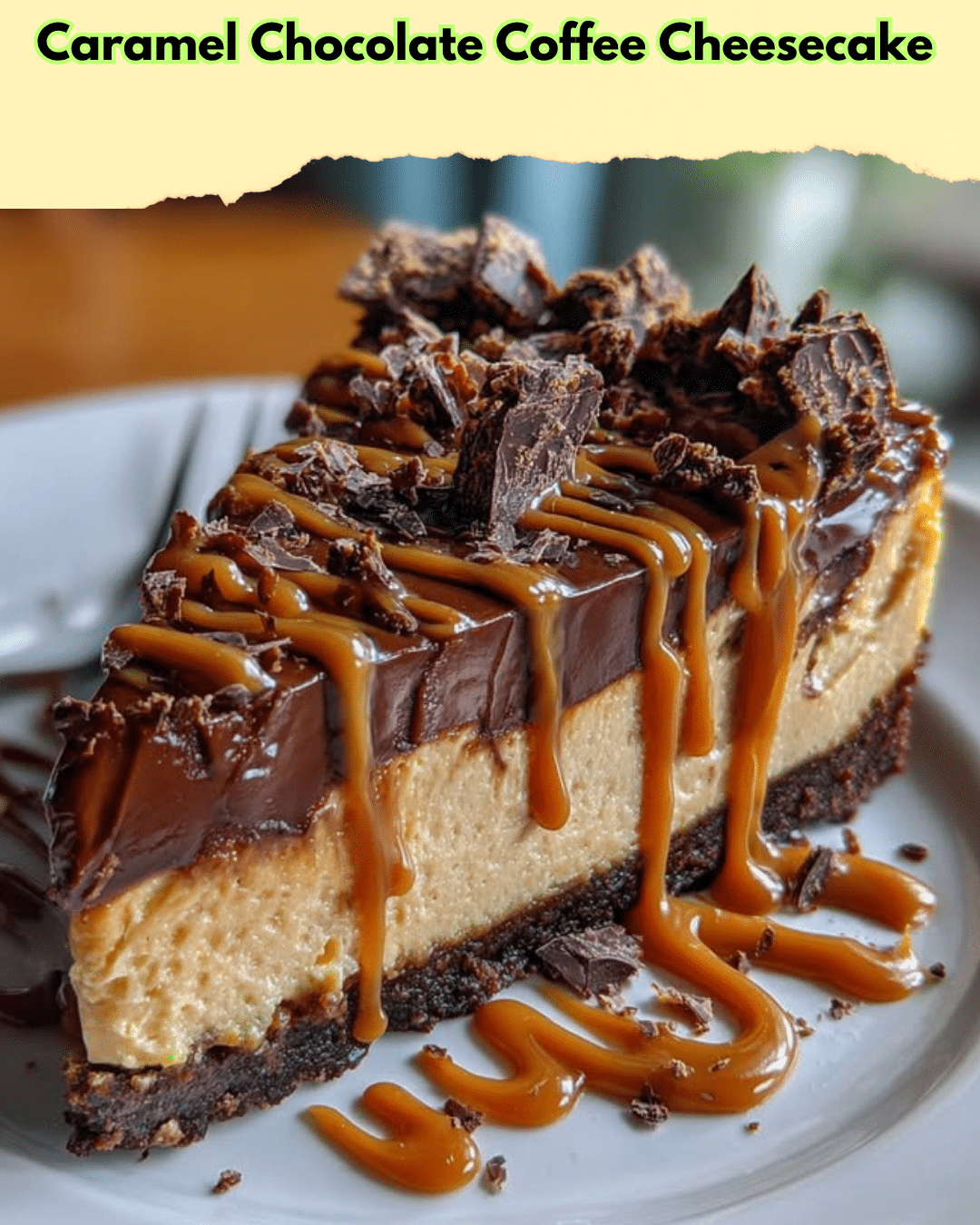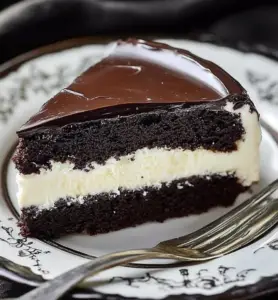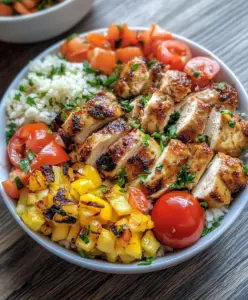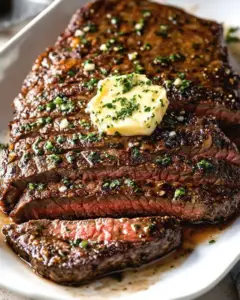Caramel Chocolate Coffee Cheesecake: A Decadent Dessert Delight
Indulge in the luscious synergy of flavors in this Caramel Chocolate Coffee Cheesecake—an ultimate dessert masterpiece. This decadent treat combines the rich, velvety textures of cheesecake with the bittersweet elegance of chocolate, the exhilarating aroma of fresh coffee, and the sweet, buttery allure of caramel. Each bite offers a luxurious experience, perfect for spoiling yourself or impressing your guests at any celebration.
Crafted with the rich interplay of three distinct yet harmonious ingredients—caramel, chocolate, and coffee—this cheesecake is designed to tantalize every taste bud. The robust coffee flavor enhances the creamy chocolate’s depth, while caramel adds a lovely pop of sweetness that’s hard to resist. Whether you’re a seasoned baker or a novice exploring the world of desserts, this cheesecake promises a satisfying journey filled with enchanting aromas and delightful textures.
Quick Recipe Highlights
- Flavor Profile: Experience the harmony of creamy chocolate punctuated by bold coffee flavors and a hint of sweet caramel.
- Texture: Enjoy a silky smooth cheesecake filling on a firm crust, completed with a delightful, slightly chewy caramel topping.
- Aroma: Immerse yourself in an aromatic blend of dark chocolate and roasted coffee, accentuated by the sweet note of caramel.
- Visual Appeal: A perfectly layered cheesecake with a glossy caramel glaze presents a visual feast for any table setting.
- Skill Level Needed: Requires some baking experience—an excellent opportunity for those looking to enhance their culinary skills.
- Special Equipment: A springform pan and a water bath setup are essential for achieving the perfect cheesecake texture.
Recipe Overview
- Difficulty Level: A medium level of difficulty due to the careful layering of flavors and textures, as well as the need to manage a water bath effectively.
- Category: This indulgent dessert is perfect for anyone craving a rich, sophisticated cheesecake with complex flavors.
- Cuisine: While originating from traditional American cheesecakes, this dish incorporates European influences with its usage of rich chocolate and coffee.
- Cost: Estimated around $25, with the chocolate and cream cheese making up the bulk of the cost, balanced by the relative affordability of other ingredients.
- Season: Ideal for cold weather when the rich, warming flavors can be fully appreciated; however, it’s popular year-round for special occasions.
- Occasion: Perfect for gatherings, holidays, or any time you wish to serve an exquisite dessert that impresses and satisfies.
Why You’ll Love This Recipe
This Caramel Chocolate Coffee Cheesecake captivates with its rich and intricate taste, offering a satisfying balance of creamy textures and diverse flavors. The pairing of chocolate with coffee creates a delightful depth, while the caramel contrasts with a pleasant sweetness, making for an unforgettable culinary experience.
In terms of preparation, this cheesecake is as convenient as it is luxurious. Despite its intricate flavor layers, it’s surprisingly manageable in terms of time and effort—a testament to how sophisticated desserts don’t always require elaborate techniques or unrealistic time commitments.
Nutritionally, this cheesecake provides a rich source of dairy from the cream cheese, with an additional kick of caffeine from the coffee. While indulgent, it offers satisfaction through its natural ingredients, designed to be enjoyed in balanced moderation as part of a wholesome dessert repertoire.
In a social setting, this cheesecake is sure to be the star of the table—its polish and presentation alone garner admiring attention, while the taste ensures delightful reviews. Whether for an extravagant party or a special night-in, it encourages connectivity over a shared love for good food.
Cost-effectiveness combines with accessibility, as the core components of the cheesecake dough are readily available in most grocery stores. This ensures that crafting this show-stopping dessert remains within the realm of many cooking budgets, adding a touch of luxury without excessive expenditure.
Historical Background and Cultural Significance
The Caramel Chocolate Coffee Cheesecake holds roots in classic American cheesecake traditions, which date back to ancient Greece but were refined throughout Europe in the Renaissance. Introduced in the New World, cheesecakes evolved, incorporating local ingredients and beloved flavors like chocolate and coffee.
Culturally, cheesecake has become not only a dessert but a celebration centerpiece worldwide. The addition of chocolate adds a rich European flair, historically linked with indulgence and luxury, while coffee introduces an Italian element, reflecting the global influences encapsulating modern culinary traditions.
Across the decades, the cheesecake recipe has evolved, accommodating diverse taste preferences and fusions that reflect culinary innovation and creativity. The blending of caramel, chocolate, and coffee demonstrates this evolution—showcasing the versatility and universal appeal of cheesecake variations.
Regionally, variations abound—Italian cheesecakes often feature ricotta, while Jewish versions may lean heavily on cream cheese. Modern innovation witnesses caramel’s inclusion, a nod to the delightful flexibility of dessert-making and its endless ability to adapt with chocolatier trends and coffee culture.
Ingredient Deep Dive
Caramel plays a pivotal role in this recipe, providing a sweet, nuanced topping that complements the cake’s richness. Caramel originates from the ancient art of cooking sugar, traditionally involving boiling sugar until it achieves a soft, golden state. When combined with cream or butter, it transforms into a luscious sauce. Nutritionally, caramel should be enjoyed sparingly due to its high sugar content, but its taste pays off in terms of flavor complexity.
Chocolate brings the signature decadence to this cheesecake. Historically, chocolate’s journey from a bitter drink in Mesoamerican cultures to the solid confections we adore today represents its adaptability and versatility. Packed with flavonoids, dark chocolate offers antioxidants but should be chosen with a higher cocoa content for optimal health benefits.
Coffee enhances this dessert with a flavor that’s both awakening and captivates the senses. Coffee’s arrival in Europe in the 17th century influenced not only daily life but also cooking, offering aromas and bitterness that balance sweet desserts. Nutritionally, moderate coffee consumption is rich in antioxidants and associated with several health benefits.
Cheesecake’s base, cream cheese, offers a creamy texture and tangy flavor, forming the foundation of the dish. Originating in American-style cheesecake, it provides supreme smoothness when mixed into batters. Though calorific, cream cheese includes essential nutrients from dairy but should be balanced within a diverse diet.
Common Mistakes to Avoid
- Overmixing the batter, which can introduce excess air and cause unsightly cracks on top of the cheesecake. Maintain a moderate mixing speed.
- Skipping the water bath, leading to uneven cooking and potential cracking. Ensure your springform pan is sealed to prevent water leakage.
- Using cold ingredients right from the fridge. Allow cream cheese and eggs to reach room temperature for smooth blending.
- Resisting the temptation to open the oven door during baking, which can lead to temperature fluctuations and cracking.
- Not adequately allowing for chilling time, which may result in a less firm cheesecake consistency.
- Omitting the use of parchment paper or greasing, causing the crust to stick to the pan.
- Misjudging ingredient measurements; precision ensures the best texture and flavor balance.
- Using a sharp knife to cut, without wetting; implementing warm, damp blades will give cleaner, neater slices.
- Rushing the cooling process, leading to compromised texture by drastic temperature change.
- Ignoring quality caramel, chocolate, or coffee; inferior ingredients won’t deliver the desired richness and taste.
Essential Techniques
The proper execution of a water bath is vital to achieve the right cheesecake consistency. This technique creates a gentle, even heat, essential for preventing cracks and ensuring the center cooks thoroughly. Master this by fully sealing the cheesecake with foil and maintaining an inch or two of hot water. Avoid common pitfalls like poorly sealed pans leading to water intrusion or insufficient depth of water.
Creating a caramel topping requires precise control when heating sugar, as it needs to reach the specific stage without scorching. Recognize success by the deep golden hue achieved without burning. Use a heavy-bottomed saucepan for controlled heat distribution and monitor thoroughly to avoid exceeding your target color, which could leave a bitter taste.
Layering flavors in a cheesecake by introducing ingredients like coffee, chocolate, or caramel layers needs careful attention. Ensuring even distribution is key to taste consistency across the cake. Achieve success by balancing component ratios and evenly spreading each layer before freezing or baking.
Making sure the filling is silky smooth relies on gradual incorporation of ingredients, especially cream cheese and sugar. Use room temperature components and mix slowly to avoid trapping air, which promotes a dense, rich mouthfeel, free from graininess or unpleasant lumps.
Pro Tips for Perfect Caramel Chocolate Coffee Cheesecake
For the ultimate flavor balance, utilize quality chocolate with at least 60% cocoa content to match the bittersweet notes reflective of premium confections. This richness ensures sophistication in taste, aligning well with coffee and caramel.
A great way to achieve a tightly firm crust is to pre-bake it for a few minutes; this additional step ensures it holds up against the moist cheesecake filling. Keep an eye out for slight coloring as an added indicator of readiness.
Balancing sugar content when caramelizing is crucial; tweak according to your saucepan’s heat responsiveness. Use your stovetop experience to determine the specific point when the syrup turns caramel golden, avoiding going darker unless intentionally seeking a bitter touch.
Ensure an extended cooling period for a smooth, sliceable texture. Cool for at least four hours or overnight before removing from the pan, which aids in fully incorporating all flavors harmoniously.
Avoid condensation forming on the top during cooling by keeping it uncovered, which introduces undesirable moisture, especially within the refrigerator stage.
Reserve room temperature storage if you plan to serve within a few hours, keeping the cheesecake’s delightful creamy consistency compared to chilled alternatives. Room temperature serves well for tasting all the nuances of this dessert’s flavor profile.
Variations and Adaptations
Regional variations could look at switching coffees. Espresso lends a concentrated coffee essence, while a flavored latte brings nuance, introducing distinct tasting opportunities like vanilla or hazelnut.
Let seasonality guide your selection. Fresh fruit garnish, like berries in summer, introduces bright freshness, while toasted nuts provide much warmth suited for winter, adjusting flavors and textures accordingly.
Dietary modifications might involve using reduced-fat cheese to make a lighter version or attempting a dairy-free alternative with cashew cream for vegan take. Don’t forget gluten-free crust options, such as those containing almond flour, to complement dietary needs.
For an intriguing twist, consider a layering of flavors—try white chocolate layers cut through with dark coffee layers, alternating each to lend both visual and flavor dynamic complexity.
Think texture by adding homemade toffee bits within the filling for a delightfully crunchy surprise or by running swirls of additional caramel through the filling pre-bake to create beautiful marbling effects.
Presentation modifications might involve using smaller individual tartlet molds for personal-sized servings or utilizing a dark chocolate ganache drizzle for a polished, refined aesthetic.
Serving and Presentation Guide
For a flawless serve, run a hot knife around the edge of the cheesecake before unlocking and removing the springform pan. This technique creates a clean, professional finish.
Plating should complement the flavors with dark, bold-colored plates to provide visual contrast to the cheesecake’s golden caramel hue, enhancing both color saturation and elegance.
Garnishing with whole coffee beans or chocolate shavings introduces textural intrigue, while a slight sprinkle of sea salt highlights caramel undertones and draws out intricate flavors.
Serve with additional caramel sauce on the side, offering diners control over the level of sweetness. This choice offers personalized indulgence, catering to various taste preferences.
Consider temperature by removing from the fridge 20 to 30 minutes before serving, allowing flavors to bloom fully. A cheesecake that’s too cold can mute the complexity you’ve carefully crafted.
Hints on portion control ensure proper sizing and enjoyment; aim for one to two-inch wide slices for standard serve, accounting for the cheesecake’s richness and density balanced against craving satisfaction.
Wine and Beverage Pairing
For wine pairings, consider a rich Port or a late-harvest Riesling; their sweetness and full-bodied profile match the complexity of the cheesecake, enhancing both sweetness and contrast flavors.
Opt for non-alcoholic alternatives like a bold espresso or cappuccino, which align naturally with coffee notes in the dessert, providing a deep aroma capture alongside a textural joy.
Each coffee component deserves extra care, so choose French press or cold brew to yield intense flavor, remaining aligned with the dessert’s nuanced profile.
If serving chilled, remind guests that an appropriately warm beverage can enhance flavors during cold months or opt for iced alternatives in warmer climates.
Curate appropriate suggestions based on dessert complexity, offering simple, fruity sparkling waters as palate cleansers that wash the richness away, preparing for the next delicious bite.
Storage and Shelf Life
Store this decadent cheesecake in the refrigerator, best kept within an airtight container to maintain moisture and prevent the cross-absorption of aromas from other produce.
It demands refrigeration due to the cream content but can tolerate being left at room temperature for short periods during serving without losing texture quality.
Select secure containers that protect from spills while ensuring freshness; glass locking lids could be advantageous both for clarity and containment integrity.
Watch for spoilage indicators; consider that extended storage may result in textural changes—drying cheese or cracked caramel layers could indicate aging, advising prompt consumption.
When ready to reheat for serving, avoid microwaving which can alter texture miserably. Opt for gentle oven warming, allowing gradual heat distribution to stabilize the cheesecake.
If necessary, freeze slices separately for future indulgence, taking care to individually wrap each and store within a freezer-approved container, maintaining taste and texture impeccably.
Make Ahead Strategies
When managing a make-ahead schedule, ensure you allocate appropriate time for each phase. Cheesecake tastes best when made a day in advance, fully allowing flavors to meld together.
For components like crust, these can be pre-baked and stored for short durations, wrapped securely to prevent any moisture loss, or served crisp at base strength.
Evaluate quality based on storage time frames—keep fillings separate from the entire pie if delaying assembly to prevent premature texture changes or spoilage chances.
When reheating preassembled, watchful caution maintains integrity, using gentle oven temperatures to avoid drying or cracking undesirable elements.
Avoid adding caramel drizzles until the day of serving, allowing freshness, while other toppings like chocolate shavings or fruit garnishing align well as final aesthetic touches.
Scaling Instructions
To halve this recipe, adjust ingredient ratios precisely, measuring with precision to preserve the taste balance in flavors—use a smaller pan for adequate cooking proportion.
If doubling or tripling, consider pan size expansion —the cooking method requires adjustment to accommodate deeper fillings, avoiding heat inconsistency risks.
Equipment such as larger mixing bowls and baking pans scale recipes effectively, necessitating adjustments in oven settings to ensure even cooking throughout dimensions.
Timing modifications may include extending pre-bake times; larger cheese volumes require alternating heat distribution, demanding extra diligence in process checks.
Extended storage considerations emphasize time, as larger quantities may need gradual consumption beyond initial serving days. Ensure proper preservation conditions for best results.
Nutritional Deep Dive
Interestingly, each slice of this delightful cheesecake offers a carbohydrate-rich experience, partly offset by creamy cheese protein content and healthy fat from chocolate.
Dive into micronutrient analysis; essential B vitamins present in cream cheese together with antioxidants from chocolate promote a balanced diet contribution.
Dessert’s health benefits emphasize gratification and indulgence with thoughtfulness, showcasing how a moderately portioned rich cheesecake promotes emotional and gustatory satisfaction.
Mindful dietary considerations explore ingredient choice and portioning; balancing expectations against health aspects when consuming refined sugar elements alongside calculated serving sizes.
Portion-wise, two-inch serving manages richness and dietary impact. A single indulgent slice moderately enjoyed cherishes sweetness offset by a balanced lifestyle.
Weight management aligns with strategic savoring; comply with occasional indulgences, maintaining the cheesecake within controlled rotations on a balanced diet map.
Dietary Adaptations
Optimize this delicious dessert to suit gluten-free individuals by choosing almond or gluten-free oat crust blends. These contribute texture and satisfying taste without wheat reliance.
Adjust for dairy-free versions by swapping conventional cream cheese with plant-based alternatives such as coconut cream or cashew-based replacements for a special dietary touch.
Accommodate plant-based enjoyers by employing flax seed egg replacements and vegan cheese, developing a similar texture and richness without animal-derived elements.
Low-carb adaptations consider a substitution with sugar replacements like stevia or erythritol, ensuring an enticing taste retained within carbohydrate-reduced perspectives.
Embrace the keto lifestyle effectively by using almond flour or crushed nut crusts with allulose and heavy cream-based cheese fillings diverting sugar-laden layers.—safe on ketosis triggers.
Paleo applications delight with grain-free crust versions merged with pure cocoa elements and natural sweeteners, balancing antiquely inspired health paths.
Low-FODMAP attentiveness optimizes ingredient choices, ensuring intestinal harmony for sensitive digestion, adjusted for individual tolerance through tolerance-informed ingredients compliance.
Troubleshooting Guide
Equipped to address texture issues, follow precise measurements, and use temperature awareness during cooking to keep base soft rather than overly firm and cracking.
For flavor balance pursuits, consider potential cocoa powder or salt content adjustments, identifying oversweet corrections with chocolate integration tweaking.
Temperature problems challenge arises from sudden shifts; manage oven consistency by limiting frequent door openings while keeping baking parameters stable.
In the face of equipment challenges, maintain precision by selecting compatible pieces, shunning ill-suited pans or mixers where measurements may wane, hampering cheesecake structure.
Ingredient substitutions guide alternative selection; when dairy swaps become compelling, ensure optimal nutrition and interaction consistency—solidify with credible alternatives.
Timing concerns manifest if rush compromises taste; beat deadlines with correct sequencing, avoiding early pull leading to unbaked centers or underdeveloped flavors.
Recipe Success Stories
The resounding affirmation that stunning photos capture key dessert moments arises from the community, encouraging enthusiastic attempts motivated by visual feast imagery incentives.
Endorsed adaptation showcases reader feedback with personalization, from nuts and berries to unexpected add-ons like a citrus twist, fiduciary bound enhancing ongoing recipe engagement.
Enlightened variation successes combine classic tastes with reader-driven expansions—think cinnamon infusions or pumpkin links in autumnal flavor pursuits memorialized by dessert lovers.
Reader-suggested fairs capture and develop ever-inventive flavors, exemplifying confidently executed tweaks, testifying to recipe resilience and exhilarating life beyond original construct.
Technical precision realized in visual representation reveals tips borne fruitful under astute direction—angled shots feature cross sectional integrity to capitalize mouth-watering response.
Frequently Asked Questions
Use a water bath to maintain consistent baking temperatures and avoid overmixing your ingredients which can introduce air pockets leading to cracks.
What can I do if I see moisture seeping into my pan?
Ensure that your springform pan is adequately wrapped in foil to prevent any water from seeping in during the water bath.
How do I know when my cheesecake is done?
Check for a slight jiggle in the center. If the edges have set while the center jiggles slightly, it’s time to remove it from the oven.
What is the best way to store leftovers?
Store in the refrigerator, tightly covered, and consume within four to five days for optimal quality.
Can I freeze my cheesecake?
Yes, you can freeze individual slices, wrapped tightly, for up to two months. Thaw overnight in the refrigerator when ready to eat.
What’s the ideal serving temperature?
Cheesecake tastes best slightly chilled to room temperature; consider removing it from the fridge about 30 minutes before serving.
Is there a way to make this cheesecake without coffee?
Absolutely, simply omit the coffee to create a caramel chocolate version, adjusting sweetness as necessary to retain balance.
How can I achieve a smooth, creamy texture?
Always start with room temperature ingredients and avoid overmixing your batter to maintain smoothness without air pockets.
What do I do if the top of my cheesecake browns too quickly?
Tent with foil during the last stages of baking to prevent excessive browning without altering the fundraiser.
Can I add different flavors to the cheesecake?
Feel free to infuse extracts like vanilla or almond, and customize with layers of fruit, swirls, or chocolate chips as desired.
Additional Resources
Explore related recipes focusing on other flavor combinations within the cheesecake realm, offering options such as vibrant berry, zesty lemon, or nutty pecan.
Delve into technique guides, ensuring easy to follow instructions for essential processes like water baths and caramel creation ideals safely tackled.
Experience ingredient depth by learning more about coffee bean types or choosing premium chocolates and complementary flavors.
Equip the novice baker seeking successes with recommendations highlighting tried-and-tested appliances guaranteeing recipe victories, from mixers to baking pans.
Examine seasonal variations interacting with broader diverse desserts emphasizing richness, freshness, or spiced elements capturing every yearly chapter.
Print
Caramel Chocolate Coffee Cheesecake
Description
A decadent cheesecake featuring layers of coffee-flavored cream, rich chocolate, and a luscious caramel topping.
Ingredients
For the Crust:
- 1 1/2 cups chocolate cookie crumbs
- 1/4 cup melted butter
- 24 oz cream cheese, softened
- 3/4 cup granulated sugar
- 1/4 cup brewed espresso
- 4 large eggs
- 1 cup semi-sweet chocolate chips, melted and cooled
- 1/2 cup caramel sauce
Instructions
1. Prepare the Crust:
- Preheat the oven to 325°F (165°C). Grease a 9-inch springform pan.
- Mix the chocolate cookie crumbs and melted butter in a bowl. Press into the bottom of the prepared pan.
- Beat the cream cheese and sugar until smooth. Blend in the espresso. Add eggs one at a time, beating after each addition. Pour half the batter over the crust, then drizzle half the melted chocolate over this layer. Repeat with the remaining batter and chocolate.
- Bake for 50 minutes or until the center is set. Cool completely, then chill for at least 4 hours. Before serving, drizzle the caramel sauce on top.
Notes
You can customize the seasonings to taste.




